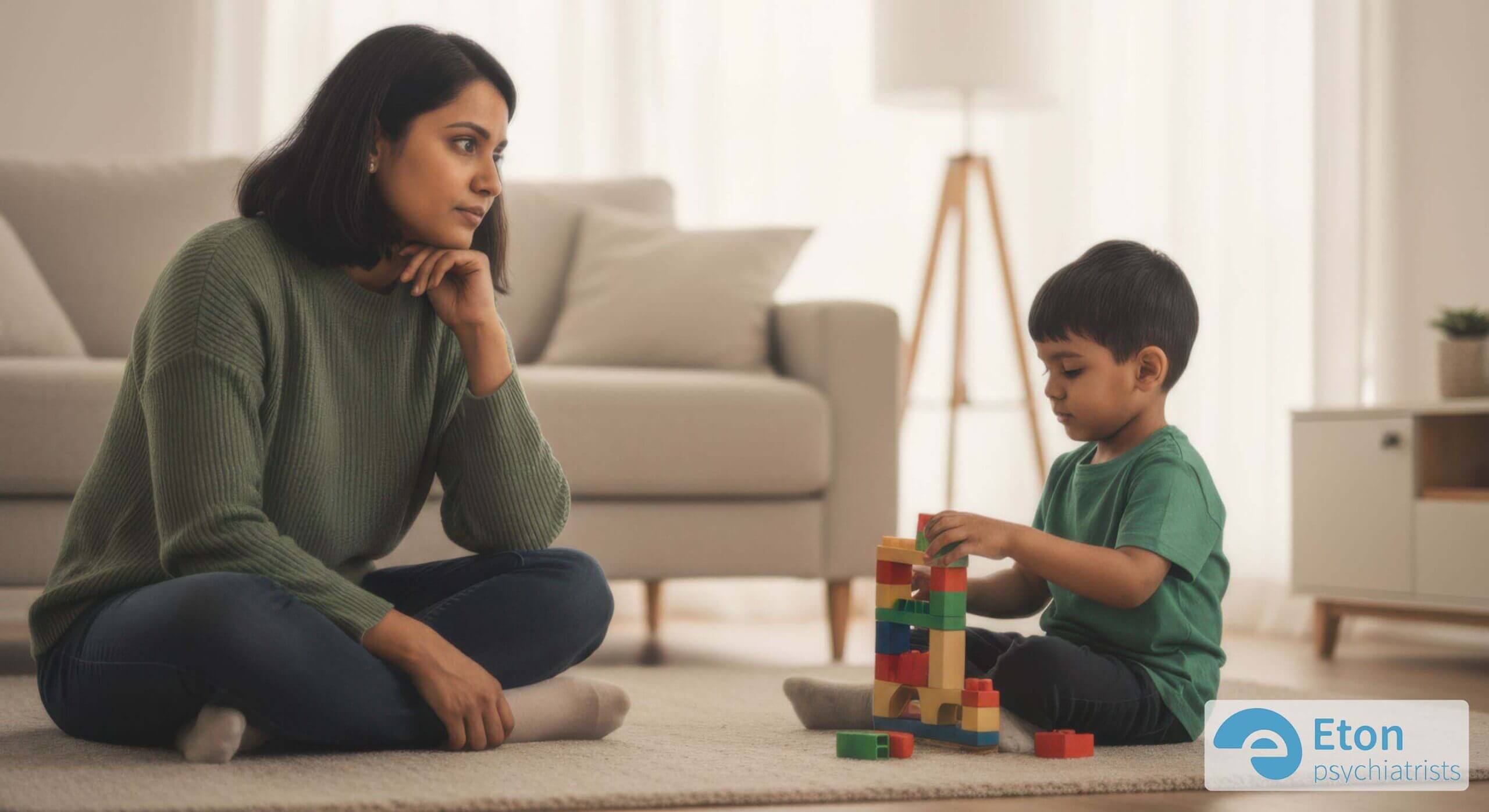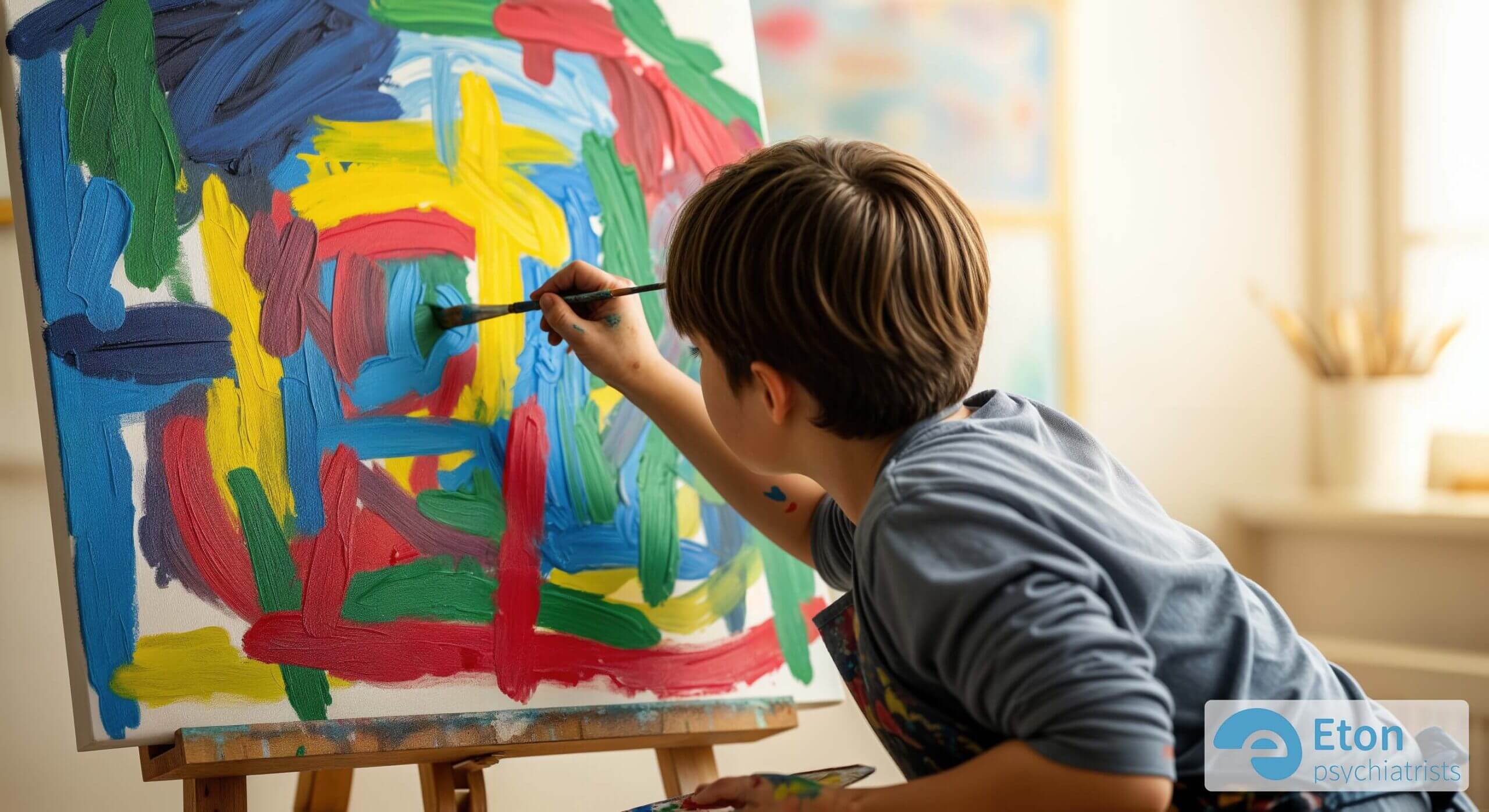
How Art and Music Help Neurodivergent Children Communicate
Listen to the Article
For those on the go or who prefer listening, you can play the full audio version of this deep dive below.

As a parent, your deepest wish is to connect with your child. But when your child is neurodivergent, standard communication can sometimes feel like trying to tune into a radio station that’s just out of reach. You know your child has a rich inner world, full of thoughts and feelings, but the words don’t always come easily. This is where art and music therapy can offer a profound breakthrough, not as a “cure,” but as a way to learn your child’s unique and beautiful language.
This guide is for parents in the UK seeking to understand how these creative therapies work. We will explore the benefits, look at the science, and provide practical steps for finding qualified support.
Table of Contents
Understanding Neurodivergent Communication
For many neurodivergent children, especially those with autism or ADHD, verbal expression can be a hurdle. It’s not a lack of intelligence or desire, but often a result of sensory overload, social anxiety, or simply processing the world differently. Their communication isn’t broken; it’s broadcast on a different frequency.
A tapping rhythm on a table, a recurring melody hummed softly, or a drawing filled with swirling colours are not random acts. They are valid and vital expressions of thought and emotion. Art and music provide natural channels for this expression, bypassing the pressure of spoken language and allowing a child’s true self to emerge.
What is Music Therapy?
A Bridge of Sound and Rhythm
Music therapy is a clinical practice that uses the innate qualities of music—rhythm, melody, and harmony—to build connection and achieve therapeutic goals. It is an evidence-based practice delivered by qualified professionals.
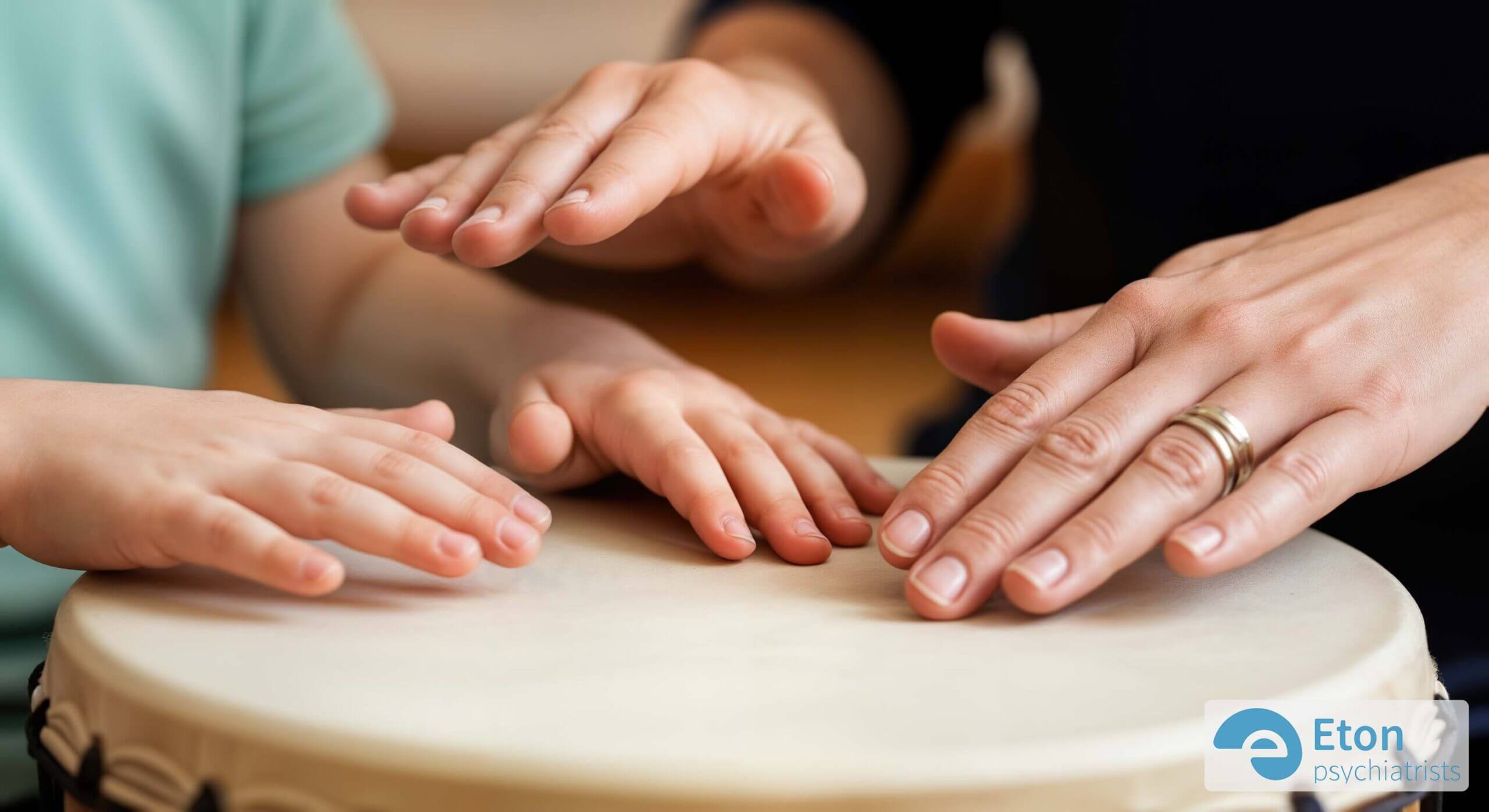
It’s More Than Just a Music Lesson
Unlike a standard music lesson focused on technical skill, clinical music therapy uses musical experiences to address non-musical goals. These goals could include improving social skills, regulating emotions, or developing communication. A qualified music therapist in the UK will have a postgraduate Master’s degree and must be registered with the Health & Care Professionals Council (HCPC), the UK’s statutory regulator for allied health professions.
How Music Builds Communication
Music offers a structured yet flexible way to interact that can feel safer than conversation. It helps neurodivergent children by:
- Fostering Reciprocity: Simple call-and-response games on a drum or piano teach the natural back-and-forth rhythm of conversation.
- Encouraging Vocalisation: Singing, even simple sounds or humming along to a melody, can be a joyful, low-pressure first step towards verbal expression.
- Improving Listening Skills: Following a beat or noticing changes in tempo helps a child tune into auditory cues from others and their environment.
- Building Social Connection: Creating music together, whether it’s a simple improvised rhythm or a shared song, builds powerful bonds without a single word needing to be spoken.
What is Art Therapy?
A Canvas for Thoughts and Feelings
Art therapy provides a tangible, visual way for children to process and communicate experiences that are too complex or overwhelming for words. It is not about creating a masterpiece; it’s about the meaning found in the process of creation itself.
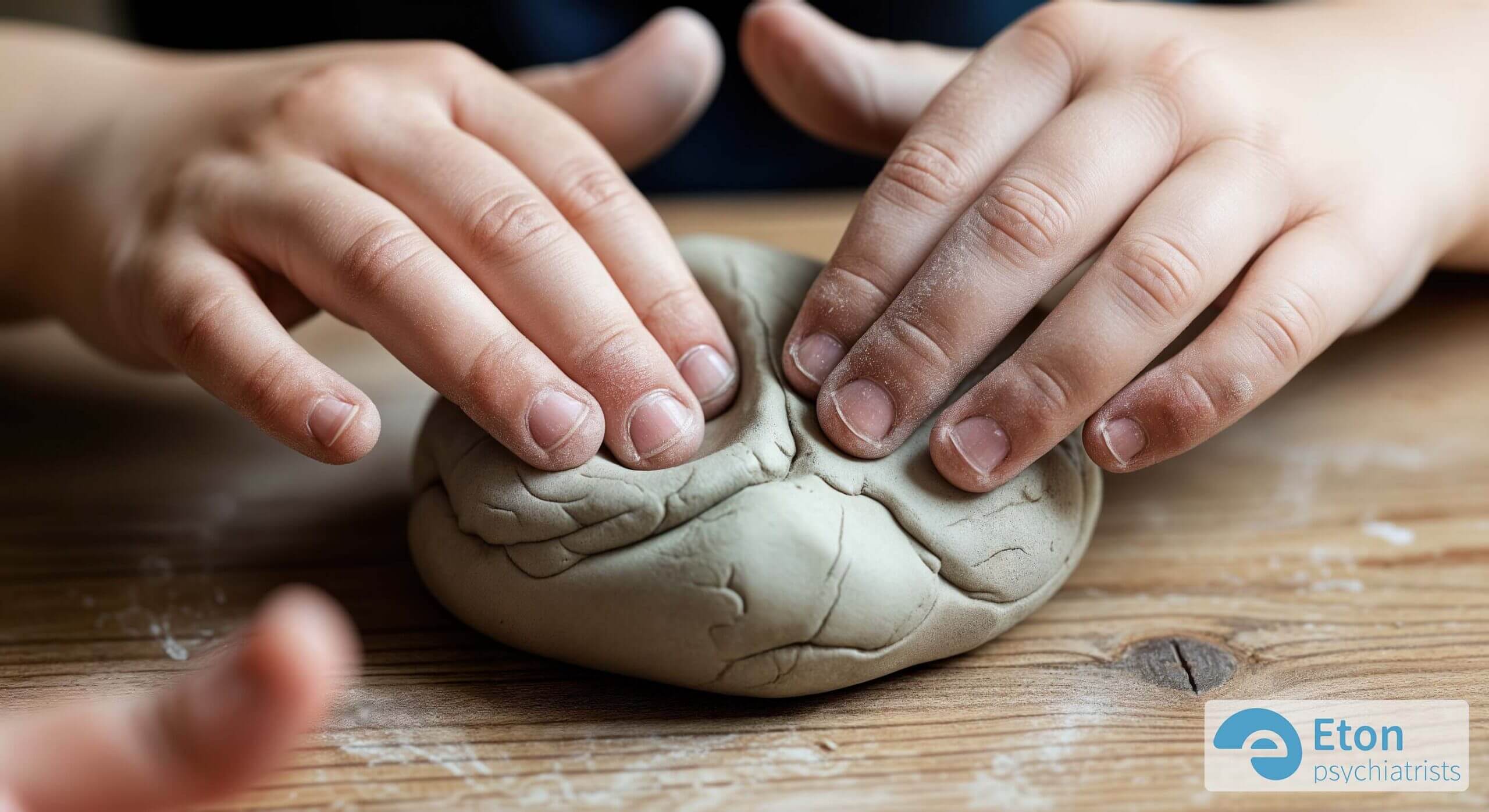
Beyond Arts and Crafts
While arts and crafts are enjoyable, clinical art therapy is a form of psychotherapy. It uses art materials as its primary mode of expression, guided by a trained Art Psychotherapist. As with music therapists, qualified art therapists in the UK are required to have a Master’s degree and be registered with the HCPC. They create a safe, confidential space where a child’s art becomes their voice.
How Art Unlocks Expression
The sensory and symbolic nature of art materials can be profoundly helpful for neurodivergent children. Art therapy supports communication by:
- Providing a Safe Outlet: A drawing of a monster or a sculpture of a tangled mess can be a safe way to express fear or confusion without having to name it directly.
- Supporting Sensory Regulation: The physical sensation of working with clay, paint, or pastels can be incredibly calming and organising for a child who struggles with sensory processing.
- Building Self-Esteem: The act of creating something tangible gives a child a sense of agency and accomplishment, building confidence that extends into other areas of their life.
- Developing Symbolic Thinking: Using colours, shapes, and images to represent feelings helps a child build a bridge between their inner experience and the outside world.
What the Evidence Shows
While stories are powerful, it’s natural for parents to ask about the scientific evidence. Research into art and music therapy is a growing field, and the results are consistently positive, particularly for neurodivergent children.
Studies have shown that music-based interventions can increase functional brain connectivity, particularly between the auditory and motor regions, which are crucial for communication (Sharda, M., et al. (2018)). A major international study on music therapy for autistic children found it helped improve social communication skills (Geretsegger, M., et al. (2022)).
Similarly, research into art therapy highlights its effectiveness in reducing anxiety and improving emotional regulation (Youn, J., & Kim, Y. (2024)). The sensory and non-verbal nature of art-making is well-suited to the neurodivergent experience. While researchers agree more large-scale trials are needed, the clinical evidence and existing studies strongly support these therapies as effective interventions.
Art or Music Therapy?
Helping You Choose the Right Path
A common question is whether to choose art or music therapy. There is no single “better” option; the best choice depends entirely on your child’s unique personality, strengths, and needs. The most critical factor for success is the quality of the therapeutic relationship with the therapist.
What to Expect in the First Few Sessions
The initial phase is usually about assessment and building trust. Typically, this involves:
- An initial consultation call with you to discuss your child’s needs and your goals.
- An assessment period of 3-6 sessions where the therapist gets to know your child.
- A collaborative meeting to discuss the therapist’s observations and agree on the goals for therapy moving forward.
Fostering Creative Communication at Home
While these activities are not a substitute for therapy, they can help you build connection and foster a creatively communicative environment at home. Remember, the goal is the process, not the product.
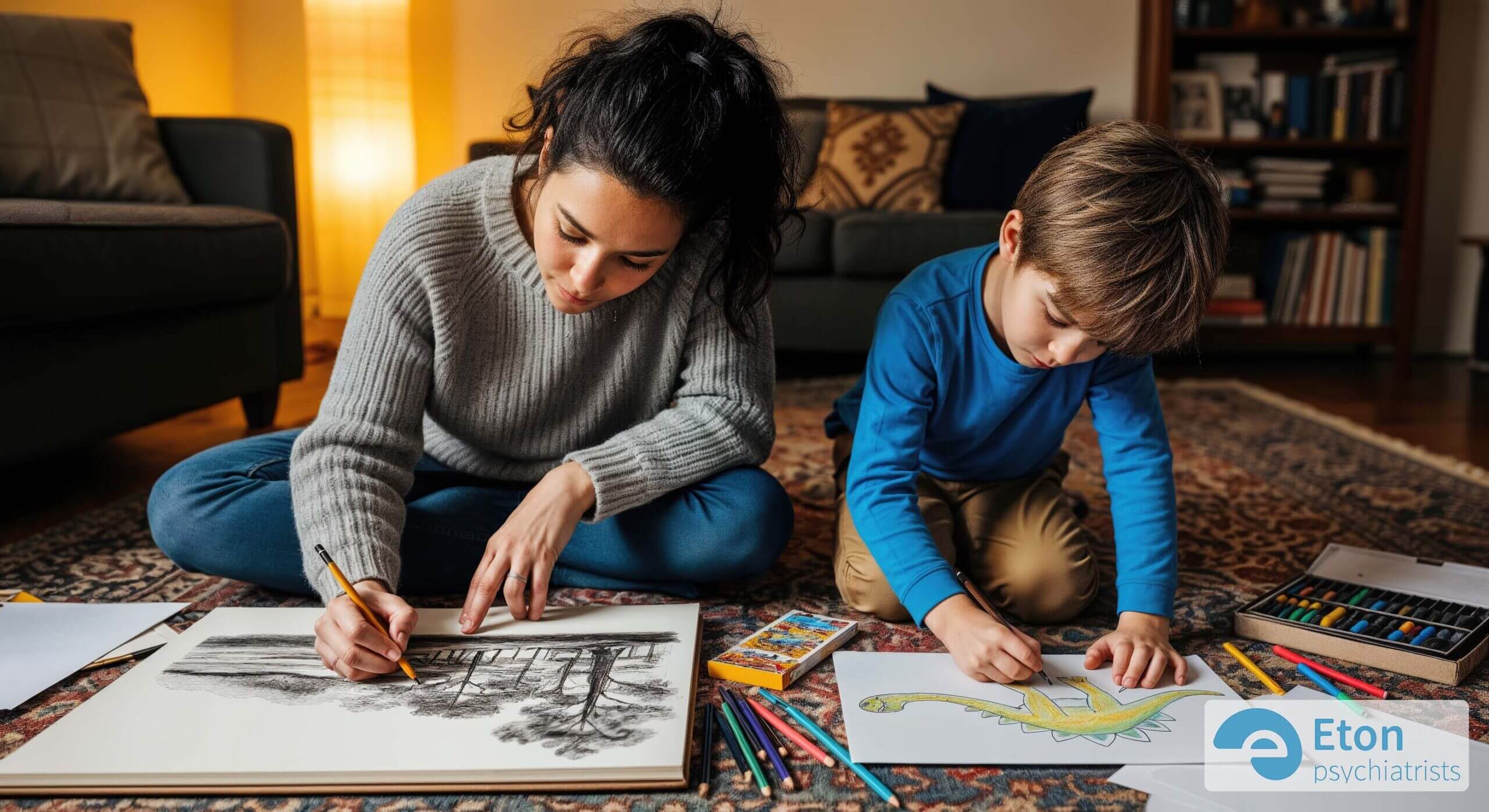
Music-Based Ideas
- Tap Back Rhythms: If your child taps a rhythm on the table, listen for a moment and then tap it back to them. This is a simple form of call-and-response.
- Create a “Feelings Playlist”: Work together to find songs for different moods—a happy song, a calm song, an energetic song. Use this to help them identify and express feelings.
- Sing Call-and-Response: Simple songs like “Row, Row, Row Your Boat” or even just singing “hello” back and forth can be powerful connectors.
Art-Based Ideas
- Parallel Drawing: Sit side-by-side with your child, each with your own paper. Don’t talk or direct, just draw together. It’s a shared experience without pressure.
- Sensory Bins: Fill a shallow box with sand, rice, water beads, or play-doh. This can be a wonderfully calming activity for sensory regulation.
- The Scribble Game: One person makes a random scribble on a page. The other person then has to turn that scribble into a picture. It’s fun and removes the pressure of starting with a blank page.
A key mindset shift: try replacing questions with observations. Instead of “What are you drawing?”, try “I see you’re using a lot of blue today.” This opens up space for your child to lead.
Why Trust Eton Psychiatrists?
At Eton Psychiatrists, our practice is rooted in a deep understanding of neurodiversity. Our team consists of highly qualified professionals specialising in ADHD, autism, and related conditions. We believe that effective support goes beyond diagnosis; it involves seeing the whole person and finding personalised pathways to help them thrive. Our approach, outlined on our about us page, integrates evidence-based psychiatric practice with a profound appreciation for the diverse ways our clients experience and communicate their world. We are committed to providing compassionate, expert care that empowers both children and their families to discover and celebrate their own unique language.
Every Child Has a Voice
Art and music therapy offer more than just a new activity. They offer a new perspective—a way to listen with your eyes and your heart. They honour the fact that every child communicates, even if they don’t use words. By embracing these creative languages, you can move beyond the frustration of not understanding and build a deeper, more authentic connection with your child.
Every tap of a drum, every stroke of a paintbrush, is a voice waiting to be heard. If you believe your child could benefit from exploring their voice through creative therapy, we encourage you to learn more.
Summary
- A New Language: The core principle is to view art and music as valid languages that can bypass the pressures of verbal communication, allowing neurodivergent children to express their rich inner worlds.
- Clinical Therapies: Art and Music Therapy are not just activities; they are clinical, evidence-based practices delivered by HCPC-registered professionals in the UK to achieve specific therapeutic goals.
- The Evidence: Research shows these therapies have a measurable impact, improving brain connectivity, social communication skills, and emotional regulation in neurodivergent children.
- Choosing a Path: The choice between art and music therapy should be guided by the child’s natural interests and sensory profile, as the relationship with the therapist is the most critical factor for success.
- Practical Steps: Parents in the UK can access therapy through school (SENCO), NHS, or private routes. It is vital to check that any therapist is registered with the HCPC.
- At-Home Support: Simple activities like parallel drawing or tapping back rhythms can help foster a creatively communicative environment at home, supporting the therapeutic process.
Frequently Asked Questions
What's the difference between a school art class and clinical art therapy?
The key difference is the goal and the guide. An art class focuses on teaching technique to create an aesthetic product. Clinical art therapy, led by an HCPC-registered psychotherapist, uses the creative process itself to help a child explore feelings, regulate emotions, and improve their mental well-being.
Do you need an official diagnosis to access therapy?
No, an official diagnosis is not always necessary, especially for private therapy. If your child is struggling with communication, emotional regulation, or anxiety, therapy can be beneficial regardless of their diagnostic status. However, a diagnosis can be helpful for accessing funding through the NHS or an Education, Health and Care Plan (EHCP).
How long does therapy usually take?
The duration of therapy varies greatly depending on the individual child and their goals. It could be a short-term intervention of a few months to address a specific issue, or it could be a longer-term process lasting a year or more to support ongoing development. The therapist will discuss this with you after the initial assessment period.

